Inventory : Operations: Landed Costs
Purpose
The purpose of this documentation is to outline the use case and processes associated with Landed Costs in Odoo 13. Landed costs are the total additional costs of a landed shipment including:
Freight
Insurance
Other Costs up to the Port of Destination.
In some instances, it may also include the customs duties and other taxes levied on the shipment.
In other words, landed costs allow you to incorporate extra costs into the total cost of a product once it has arrived at your door (Cost of Product + Shipping + Customs).
Important!
FIFO Category Configuration
A Landed Cost can only be used on products configured with the FIFO and Average costing methods. The costing method for a product is configured at the product category level, as shown below.
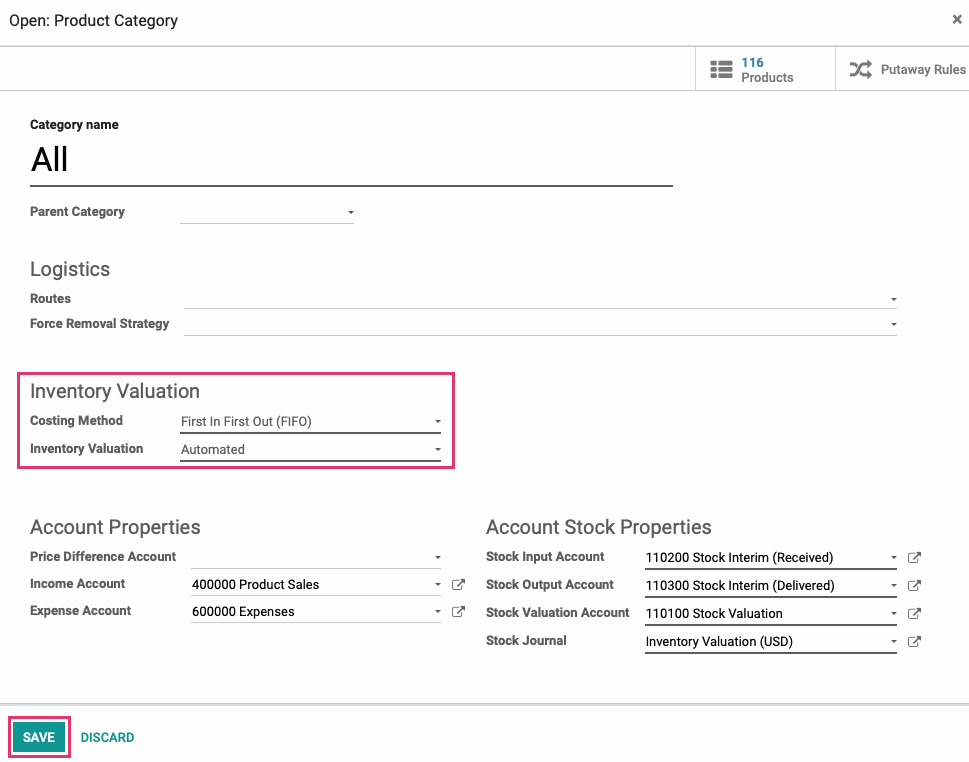
Types of Landed Costs
There are two options available to calculate Landed Costs.
Add to Vendor Bill: When Landed Costs are being charged by the product vendor (e.g. shipping, handling), you can use this method to create Landed Cost entries directly at the Vendor Bill level.
Link to Warehouse Transfer: When Landed Costs are being charged by a source other than the product vendor, you can use this method to create Landed Costs and link them to an existing Warehouse Transfer separately from the vendor bill.
We'll cover both of these methods in this section.
Process
Add Landed Costs to Vendor Bill
Since Landed Cost is based on delivery of goods, we'll first need to create a Purchase Order. To get started, navigate to the Purchase app.

Click Create to start a new Purchase Order.
In the New RFQ form, first select a Vendor. Nex,t under the Products tab, click Add a Product and select the product you'll be purchasing. Be sure to adjust the Quantity and Unit Price.
When done, click Confirm Order.
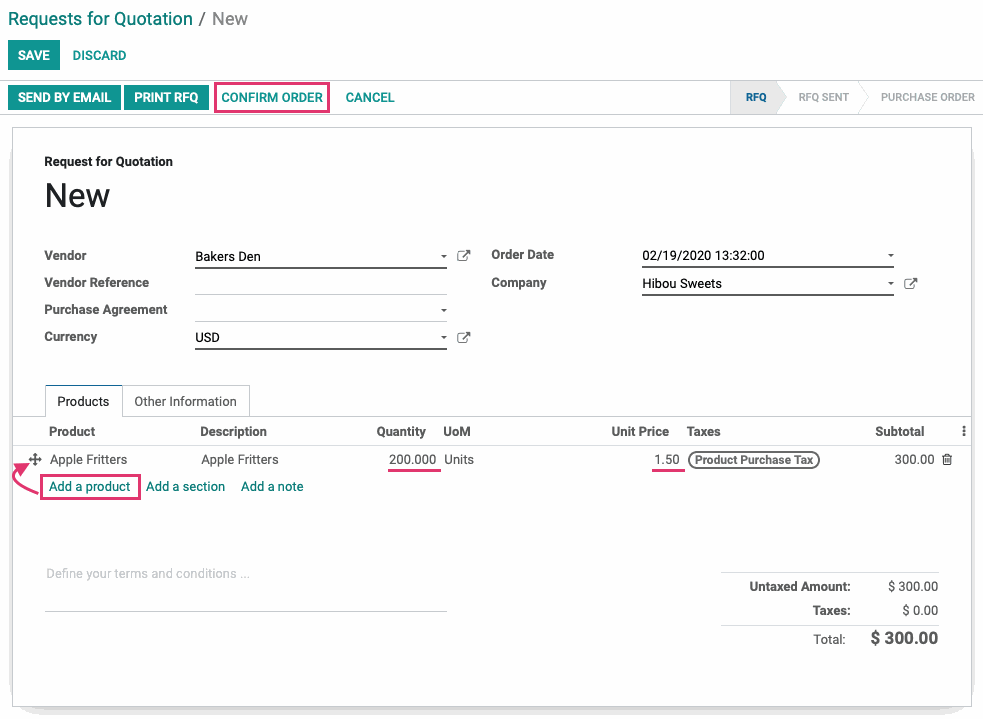
When the page reloads, click Receive Products, or the Receipts smart button.

Click Validate.

On the modal window, click Apply to verify that the full order is being received.

Copy the Transfer reference (e.g. PWH/IN/00002). You'll need to add this reference to the Landed Costs form.

Navigate back to the Purchase Order using the breadcrumbs.

To bill the products, click Create Bill.

Under the Invoice Lines tab, click Add a Line and enter any additional Landed Costs from this vendor. Mark the entry as a Landed Cost in the respective column.

Click Save before continuing.
Good to Know!
No Landed Costs column?
If you don't see the Landed Costs column, click the icon to the far right and select it from the drop-down.

Click the Created Landed Costs button, which appears as soon as you designate an Invoice Line as a Landed Cost.

This brings you to the Landed Cost form for this draft bill. Click Edit.
Date: This will auto-populate with the current date, but you can adjust it to the day of receipt, as needed.
Transfers: Add the Transfer reference you copied at the time of product receipt, then select the matching entry from the drop-down. For our example, this is PWH/IN/00002.
Journal: This is the Journal configured to record Landed Costs settings.
Vendor Bill: This field will auto-populate with the draft bill reference.
Under the ADDITIONAL COSTS tab, click ADD A LINE.
Product: This is where you'll add your additional costs, whether they be shipping fees, duties, handling, carrier charges, etc. We've summarized this as "Landed Costs" for the purpose of this example.
Description: This will auto-populate with the product name, or you can add more information here.
Account: This will auto-populate with the product's set Account.
Split Method: This is where you'll decide how to distribute the Landed Costs within the Transfers.
Equal: Cost will be equally divided by the moved lines. This is the most common method.
By Quantity: Cost will be divided based on the product quantity.
By Current Cost: Cost will be divided based on the product's current cost.
Weight: Cost will be divided based on weight.
Volume: Cost will be divided based on volume.
Cost: The total cost of this line.
When you're done, click Save, then click Compute.
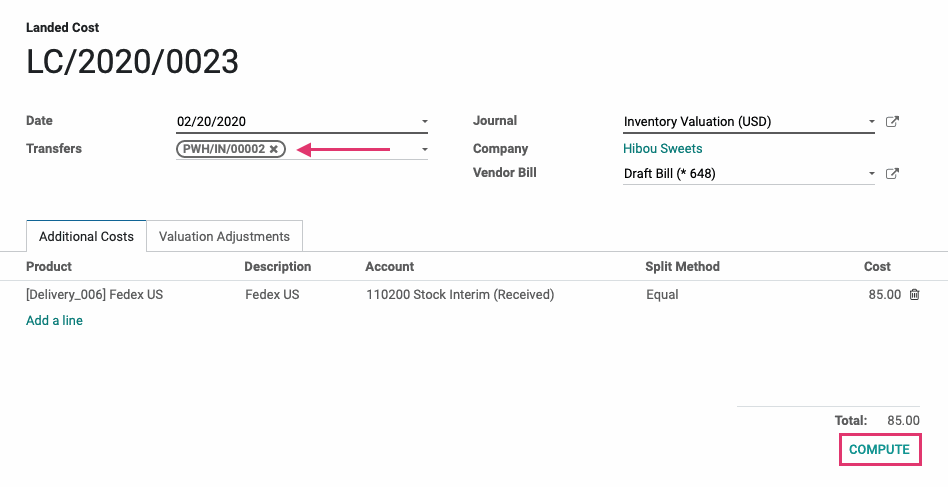
Review the new entries under the Valuation Adjustments tab. If everything looks correct, click Validate.
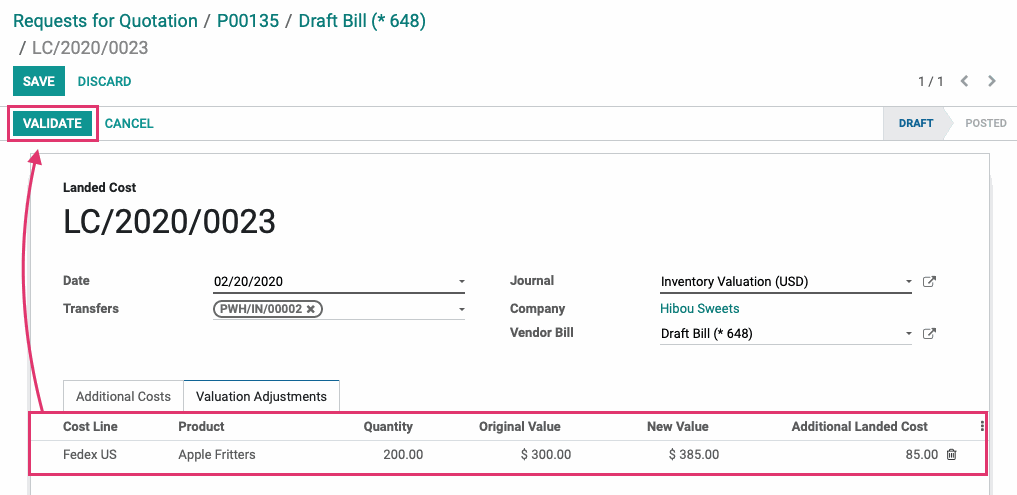
After validation, click Save, then navigate back to the bill using the breadcrumbs.

Now you'll see the new Landed Costs smart button that was added to the bill. You can always go back to the Landed Cost record using this shortcut.
Verify the information on the bill, then click Post.

Click Register Payment.

On the modal window, enter the payment information and click Validate.

Your products have now been received to the warehouse, and your vendor has been paid for both the product and the associated costs.
Link Landed Costs to a Warehouse Transfer
Since Landed Cost is based on delivery, we'll first need to create a Purchase Order. To get started, navigate to the Purchase app.

Click Create to start a new Purchase Order.
Select the Vendor, then, under the Products tab, click Add a Product and enter the product you'll be purchasing. Be sure to adjust the Quantity and Unit Price.
When done, click Save, then click Confirm Order.

When the page reloads, click Receive Products, or the Receipt smart button.

To receive the products, click Validate.

On the modal window, click Apply to verify that the full order is being received.

Picking up from the previous step where we accepted the product delivery, copy the Transfer reference. You'll need to add this reference to the Landed Costs form.

Navigate back to the Purchase Order using the breadcrumbs.

Click Create Bill.

Verify the information, then click Post.
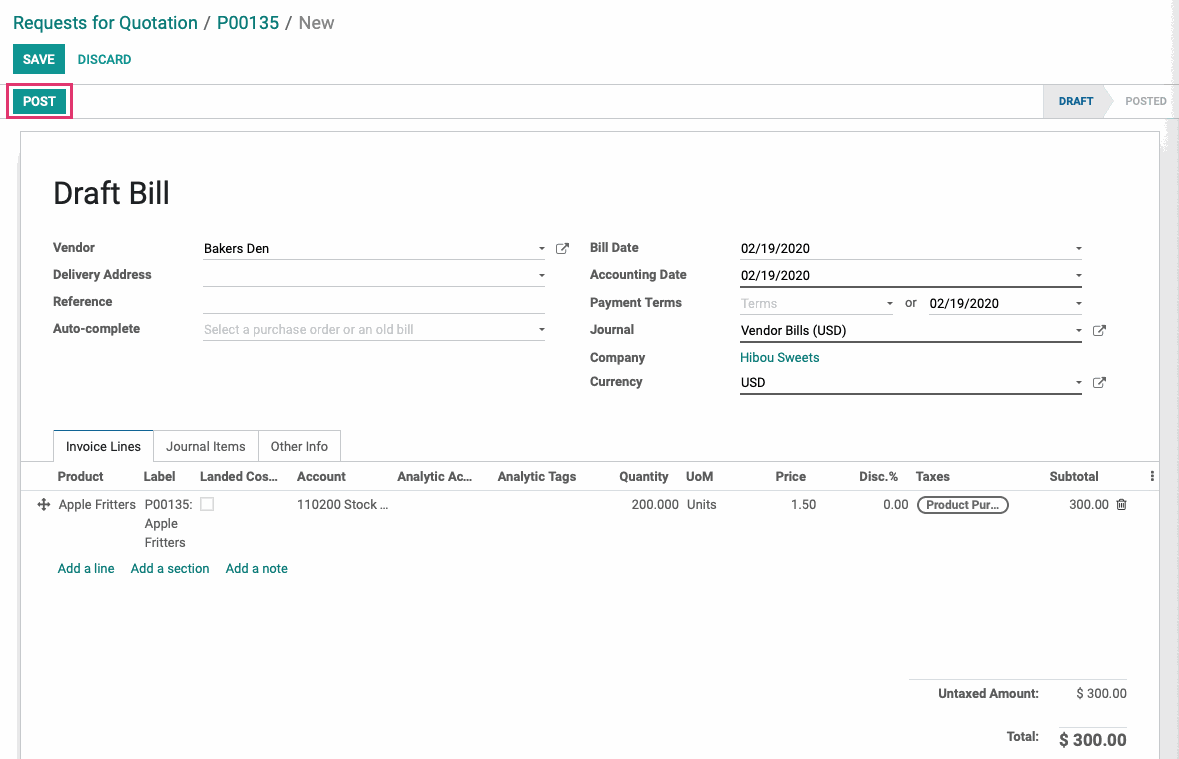
Click Register Payment.

On the modal window, enter the payment information and click Validate.

Your products have now been received at the warehouse and your vendor has been paid.
To added Landed Costs, navigate to the Inventory app.

Once there, go to Operations > Landed Costs and click Create.
This opens the Landed Costs form where you'll add additional costs for the first Vendor.
For example:
DHL has delivered your shipment to a warehouse in the next city.
A local freight company has picked up the shipment from that warehouse and delivered it to your location.
In this scenario, both will generate vendor bills related to the same Transfer order.
DHL has billed us $50, so we've created a Purchase Order for that bill, and the outgoing payment is recorded on BILL/2020/0044.
The local freight company will bill us at a later time, so we won't add them just yet.
With that information, we can fill out the Landed Costs form according to the following guidelines.
Date: This will auto-populate with the current date, but you can adjust it to the day of receipt, as needed.
Transfers: Paste the Transfer reference you copied at the time of product receipt, then select the matching entry from the drop-down. For our example, this is PWH/IN/00002.
Journal: This is the Journal configured to record Landed Costs settings.
Vendor Bill: Select the Vendor Bill that was used to pay this third-party service vendor (e.g. DHL). For our example, we'll select BILL/2020/0044.
Under the Additional Costs tab, click Add a Line.
Product: This is where you'll add your additional costs, whether they be shipping fees, duties, handling, carrier charges, etc. We've summarized this as "Landed Costs" for the purpose of this example. Make sure the Cost matches that of the Vendor Bill.
Description: This will auto-populate with the product name, or you can add more information here.
Account: This will auto-populate with the product's set Account.
Split Method: This is where you'll decide how to distribute the Landed Costs within the Transfers.
Equal: Cost will be equally divided by the moved lines. This is the most common method.
By Quantity: Cost will be divided based on the product quantity.
By Current Cost: Cost will be divided based on the product's current cost.
Weight: Cost will be divided based on weight.
Volume: Cost will be divided based on volume.
Cost: The total cost of this line.
When you're done, click Save, then click Compute.

After computing, you can click the Valuation Adjustments tab to see the results. To accept the adjustments, click Validate.
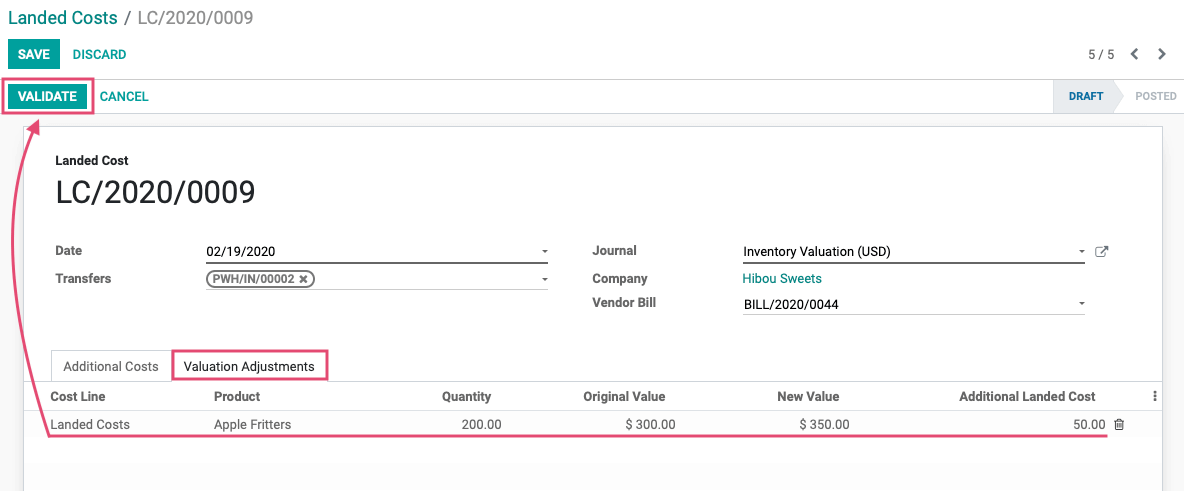
Add a Landed Costs record for each vendor bill associated with the Transfer.
Good to Know!
There may be times when you have additional costs generated from both the product vendor and one or more outside service providers. In these cases, you can use both Landed Cost methods.
Also note that you'll want to use an account that is more appropriate than the default "Stock Interim Received" which typically means an expense account such as Shipping, for example. When the landed cost is applied, you will "relieve" the expense from the account you set on the vendor bill and roll it into your inventory valuation.
How Landed Costs Affect Product Pricing
Let's take a look at how Landed Costs affect the pricing of the associated product. You'll need to sell through existing on hand product to initiate the product Cost update if FIFO or you'll see it immediately update if Average.
View New Pricing
To see the updated pricing that was calculated based on the Purchase Order and Landed Costs adjustments, navigate to the Inventory application.

Once here, click Master Data > Products. Click the demo product to see details.

Under the General Information tab, you'll see the new adjusted price.
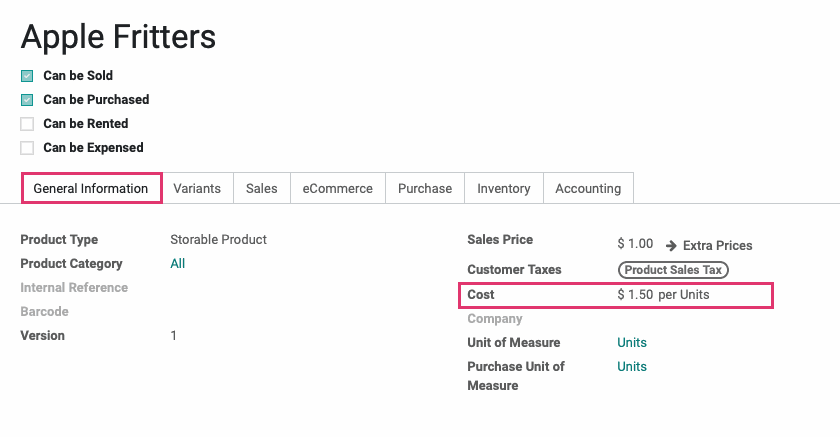
Now you can use this calculated cost to determine a competitive, yet profitable, Sales Price.